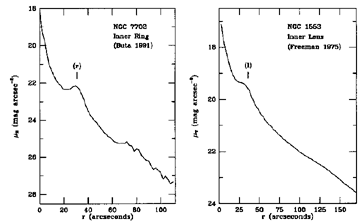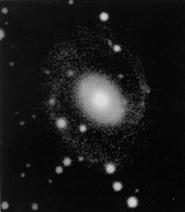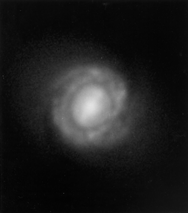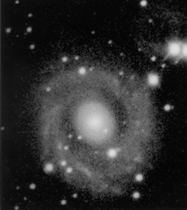
|



4.2. Inner, Outer, and Nuclear Lenses
Rings are also related to other features known as lenses. Lenses are by definition rather shallow parts of the luminosity profiles which appear to have sharp edges on photographs. The photometric distinction is illustrated in Figure 20. This plot shows that the difference between a ring and a lens can be in part a question of the amplitude of the enhancement over the declining background of the bulge plus disk components. This does not mean that rings and lenses are the same phenomenon, because rings can exist in the absence of a lens. Nevertheless, old ring stars may eventually populate a broader region after many orbits (see sections 9.4 and 15.1).

|
There is a lens analogue for each type of ring, as shown in Figure 21. Often, a ring is a subtle enhancement at the edge of a lens. Although lenses have been recognized for a long time (see Sandage 1961, 1975; de Vaucouleurs 1959a; Freeman 1975; Kormendy 1977; Sandage & Brucato 1979; de Vaucouleurs & Buta 1980a), no specific symbol was used to denote their presence, and in published catalogues (e.g., RC1, RC2, and RC3), a lens may be classified as an inner ring (e.g., NGC 1553). Kormendy (1979a) proposed that lenses should be distinguished from rings, and suggested the following notation: (l) for inner lenses and (L) (2) for outer lenses. This notation was adopted in the Catalog of Southern Ringed Galaxies (Buta 1995), and apart from Kormendy (1979a) is the only major source of consistent lens classifications. Buta (1989) proposed the notation (nl) as an obvious extension of Kormendy's suggestion for nuclear lenses. The left panels in Figure 21 show two early-type spirals with prominent inner lenses but little trace of a bar. The lower right panel shows NGC 2983, an SB0+ galaxy with a strong outer lens, while the upper right panel shows the central region of NGC 1317, an SAB galaxy with a prominent nuclear ring, a secondary bar, and a small nuclear lens surrounding the bar. In this latter case, the nuclear lens is not coincident with the edge of the nuclear ring but is coincident with the ends of the secondary bar (see Schweizer 1980). A nuclear or secondary lens in NGC 1291 was also described by de Vaucouleurs (1975a), again surrounding a secondary bar. We discuss in section 15.1 the formation and evolution of lenses.

| 
|

| 
|